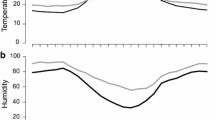Summary
Four colonies of the column-forming termiteHospitalitermes hospitalis (Haviland) were studied in a primary forest in Brunei Darussalam, north-west Borneo, and their trails mapped. The termites leave their nest in the afternoon to graze throughout the night, mainly on lichens growing high up on the trunk of a canopy tree. Colonies foraged from 46% to 72% of nights, and the mean and maximum trail length was 28.8 m and 65.2 m respectively. Each colony utilized between 14 and 26 trees, with many trees revisited and trails frequently re-used. The mean diameter of the utilized trees was significantly larger than the mean diameter of trees in the population at the study site. Termites often made consecutive foraging visits to the largest trees, particularlyShorea spp. At three colonies per hectare the nest density is lower than expected as more than 90% of potentially suitable trees are not exploited.
Similar content being viewed by others
References
Abe, T., 1979. Studies on the distribution and ecological role of termites in a lowland rain forest of West Malaysia. 2. Food and feeding habits of termites in Pasoh Forest Reserve.Jap. J. Ecol. 29:121–135.
Brian, M. V., 1983.Social insects.Ecology and behavioural biology. Chapman and Hall, London, 377pp.
Chuah, C. H., S. H. Goh, G. D. Prestwich and Y. P. Tho, 1983. Soldier defense secretions of the Malaysian termiteHospitalitermes umbrinus (Isoptera, Nasutitermitinae).J. Chem. Ecol. 9:347–356.
Collins, N. M., 1979. Observations on the foraging activity ofHospitalitermes umbrinus (Haviland), (Isoptera: Termitidae) in the Gunung Mulu National Park, Sarawak.Ecol. Ent. 4:231–238.
Collins, N. M., 1983. The utilization of nitrogen resources by termites (Isoptera). In:Nitrogen as an ecological factor (J. A. Lee, S. McNeill and I. H. Rorison, Eds.), Blackwell Scientific Publications, Oxford, pp. 381–412.
Collins, N. M., 1988. Termites. In:Malaysia (Earlof Cranbrook, Ed.), Pergamon, Oxford, pp. 169–211.
Emerson, A. E., 1955. Geographical origins and dispersal of termite genera.Fieldiana, Zool. 37:465–521.
Fewell, J. H., 1988. Energetic and time costs of foraging in harvester ants,Pogonomyrmex occidental.Behav. Ecol. Sociobiol. 22:401–408.
Gordon, D. M., 1991. Behavioral flexibility and the foraging ecology of seed-eating ants.Am. Nat. 138:397–411.
Hölldobler, B. and C. J. Lumsden, 1980. Territorial strategies in ants.Science 210:732–739.
Jander, R. and K. Daumer, 1974. Guide-line and gravity orientation of blind termites foraging in the open (Termitidae:Macrotermes, Hospitalitermes).Ins. Soc. 21:46–69.
Jones, D. T., in press. A quantitative survey of the termite assemblage and its consumption of food in lowland mixed dipterocarp forest of Brunei Darussalam. In: Proceedings ofTropical Rain Forest Research — Current Issues, Kluwer Academic Publishers, Dordrecht.
Kalshoven, L. G. E., 1958. Observations on the black termites,Hospitalitermes spp., of Java and Sumatra.Ins. Soc. 5:9–30.
Petch, T., 1913. The black termite of Ceylon.Ann. R. b. Gdn. Peradeniya 5:395–420.
Poulsen, A. D., in press. Variations in abundance and species richness of ground herbs within a 1-hectare plot of lowland rain forest of NW Borneo. In: Proceedings ofTropical Rain Forest Research — Current Issues, Kluwer Academic Publishers, Dordrecht.
Poulsen, A. D., I. C. Nielsen, S. Tan and H. Balslev, in press. A quantitative inventory of trees in one hectare of mixed dipterocarp forest in Temburong, Brunei. In: Proceedings ofTropical Rain Forest Research — Current Issues, Kluwer Academic Publishers, Dordrecht.
Prestwich, G. D., 1984. Defense mechanisms of termites.Ann. Rev. Entomol. 29:201–232.
Stuart, A. M., 1969. Social behaviour and communication. In:Biology of Termites, Vol. 1 (K. Krishna and F. M. Weesner, Eds.), Academic Press, London, pp. 193–232.
Tho, Y P., 1992. Termites of Peninsular Malaysia.Malay. Forest Rec. No. 36.
Whitmore, T. C., 1984.Tropical rain forests of the Far East. Oxford University Press, Oxford. 352pp.
Wood, T. G., 1978. Food and feeding habits of termites. In: Production ecology of ants and termites (M. V. Brian, Ed.), Cambridge University Press, Cambridge, pp. 55–80.
Ydenberg, R. and P. Schmid-Hempel, 1994. Modelling social insect foraging.TREE 9:491–493.
Author information
Authors and Affiliations
Rights and permissions
About this article
Cite this article
Jones, D.T., Gathorne-Hardy, F. Foraging activity of the processional termiteHospitalitermes hospitalis (Termitidae: Nasutitermitinae) in the rain forest of Brunei, north-west Borneo. Ins. Soc 42, 359–369 (1995). https://doi.org/10.1007/BF01242164
Received:
Revised:
Accepted:
Issue Date:
DOI: https://doi.org/10.1007/BF01242164




